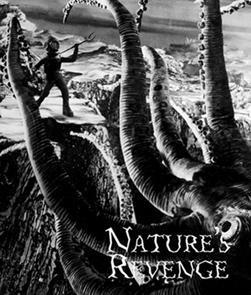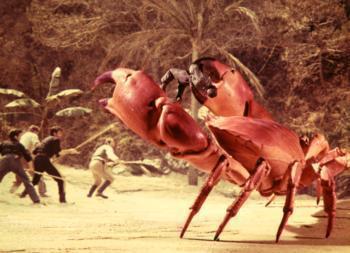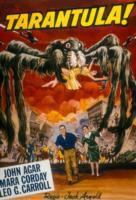RB: So many people say “If we don’t do it today, it’s not going to work.” Then I’ll say, “Did you see Star Wars? You know the band that’s in the cantina was shot six months later in a whole different country, by a whole different group of people, and you would swear that they’re there in that cantina.”
JL: But that used to be standard! That’s filmmaking!
RB: Yeah, that’s what’s missing now though, isn’t it? (Laughs.)

The Fabulous World of Jules Verne[aka A Deadly Invention, Karel Zeman, 1958] Czech filmmaker Karel Zeman’s unique blend of live action, stop motion, and drawn animation reproduces the look of 19th-century etchings, which works wonderfully well in this fusion of two Jules Verne novels.
NATURE’S REVENGE
Whether it is rats, spiders, snakes, bees, sharks, or just big old mean dogs, we are all afraid of some animal out there. Movie makers, constantly searching for something to scare us with, have shamelessly taken advantage of our reasonable fears of bee stings, spider bites, and being devoured by sharks, by featuring these and other beasties in horror films.
Producers and directors can take a real creature and make it gigantic, like the crab in Mysterious Island[Cy Endfield, 1961] or the spider—“Crawling Terror, 100 Feet High”—in Tarantula![Jack Arnold, 1955], or they can just unleash vast numbers of the critters we dread: bees in The Swarm[Irwin Allen, 1978]; or snakes in Snakes on a Plane[David R. Ellis, 2006]. If a vast, unstoppable army of ants in The Naked Jungle[Byron Haskin, 1954] isn’t enough to scare you, then how about the REALLY HUGE ants of Them![Gordon Douglas, 1954] or Empire of the Ants[Bert I. Gordon, 1977]? If the rats made you uneasy in Willard[Daniel Mann, 1971], schlock producer’s logic says that the giant rats in The Food of the Gods[Bert I. Gordon, 1976] should reallymake you jump out of your seat.
I can imagine the writer’s pitch now: “The great white shark that terrorized the beaches in Jaws[Steven Spielberg, 1975] was puny! He just wasn’t really that big! How about a Mega Shark?” “Yes! Yes!” shouts the producer. “And he could battle a Giant Octopus!” And that is how Mega Shark vs. Giant Octopus[Jack Perez as Ace Hannah, 2009] was born. In that film, the absurdly big Mega Shark destroys San Francisco’s famed Golden Gate Bridge, which had obviously been repaired since 1955 when it was heavily damaged by the giant octopus in Ray Harryhausen’s It Came From Beneath the Sea[Robert Gordon, 1955].
If worms give you the creeps, then the millions of flesh-eating bloodworms in Squirm[Jeff Lieberman, 1976] will make you do just what the title says. In The African Queen[John Huston, 1951] the audience shared Humphrey Bogart’s character’s revulsion when he came out of the water covered in leeches. If a few normal-size leeches generated such disgust, then an Attack of the Giant Leeches[Bernard L. Kowalski, 1959] is the only way to go.
It isn’t always necessary to make something we naturally avoid, like a scorpion, into a colossal version of itself to frighten us. ( The Black Scorpion[Edward Ludwig, 1957] did that with stop-motion animation by the great Willis O’Brien.) Sometimes a rabid dog [ Cujo, Lewis Teague, 1983] or just an angry grizzly bear [ Grizzly, William Girdler, 1976] is enough to terrify us without the use of special effects.
Usually, the giant animal monster is explained by some pseudo-scientific theory: it’s a prehistoric beast frozen in ice, or a mutant, created by atomic radiation. The monster is sometimes created by toxic waste or by some covert corporate or government experiment gone terribly wrong. The man-eating piranha in Joe Dante’s Piranha[1978] are the results of a misguided military experiment, while in the 2010 remake, Piranha 3D[Alexandre Aja], the vicious piranha are prehistoric fish freed from an underwater cavern by an earthquake. The change reflects the politics of the era in which each film was made.
Sometimes the reason for nature turning on us is unexplained. When Alfred Hitchcock’s The Birds[1963] attack and kill, no reason is given for their behavior. The characters speculate on what could be making the birds turn suddenly homicidal, but the movie deliberately offers no solution to the mystery and ends on an uneasy, unresolved note.
Creature From the Black Lagoon[Jack Arnold, 1954] is a classic story of an ancient species destroyed by contact with modern civilization, essentially the plot of the first half of King Kong[1933]. The Gill-Man was designed by Millicent Patrick and is considered to be one of the greatest monsters in film history. The celebrated sequence where Julie Adams is swimming on the surface of the lagoon, unaware of the Creature as it swims beneath her, remains one of the most poetic in the genre. A B movie made almost entirely on the back lot of Universal Studios (except for the underwater sequences, shot in the crystal-clear waters of Wakulla Springs, Florida) Creature From the Black Lagoonwas a great success and is still one of the best 3D movies ever made. Two sequels followed, in which the Gill-Man continued to be abused by the human leads.
Other humanoid, water-based creatures include The Monster of Piedras Blancas[Irvin Berwick, 1959], the very silly fish-men of Horror of Party Beach[Del Tenney, 1964], and the infamous Humanoids From the Deep[Barbara Peeters, 1980]. Infamous because the producer, Roger Corman, had additional scenes shot in which the monsters were shown actually raping the nubile young girls hired to be topless and scream as the slimy fish-men, created by make-up maestro Rob Bottin, had their way with them. And to increase the sleaze factor, the movie ends with one of the rape victims giving birth to a baby fish monster by having it burst through her stomach in a geyser of blood, in blatant imitation of the “chest burster” scene in Ridley Scott’s Alien[1979].
Underwater is not the only place we will find humanoid monsters—they also come from underground. The scary, carnivorous cave dwellers a group of women encounter in Neil Marshall’s The Descent[2005] are very nasty indeed. Be warned, this is definitely not a movie for the claustrophobic. Deep in the bowels of the Earth can also be found The Mole People[Virgil W. Vogel, 1956], who are used as slave labor by a race of “Sumerian Albinos!”
Another movie that features an insatiable underground threat is Ron Underwood’s Tremors[1990]. Kevin Bacon and Fred Ward play two contemporary cowboys trying to deal with the huge subterranean monsters they discover in a small town in the Nevada desert. Tremorsis a textbook example of a well made and entertaining monster movie.
Nature’s Revenge[ Book Contents]
Mysterious Island [Cy Endfield, 1961]
The castaways fight a giant crab on Captain Nemo’s island. Ray Harryhausen animated an actual crab shell purchased at Harrods Food Hall in London.

Nature’s Revenge[ Book Contents]
Tarantula! [Jack Arnold, 1955]
The tremendous tarantula in the movie never holds a woman as illustrated here in the ad art. It was not unusual for exploitation picture promotional art to exaggerate.

Nature’s Revenge[ Book Contents]
The Swarm [Irwin Allen, 1978]
Olivia de Havilland wonders how her career ever came to this. Henry Fonda and Michael Caine are also in this ridiculous Irwin Allen movie.